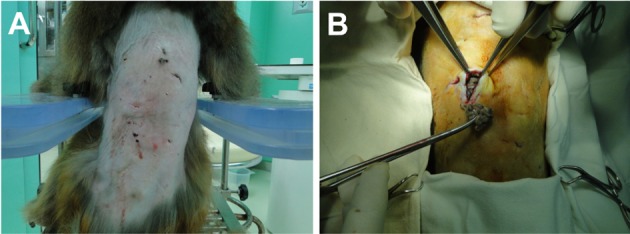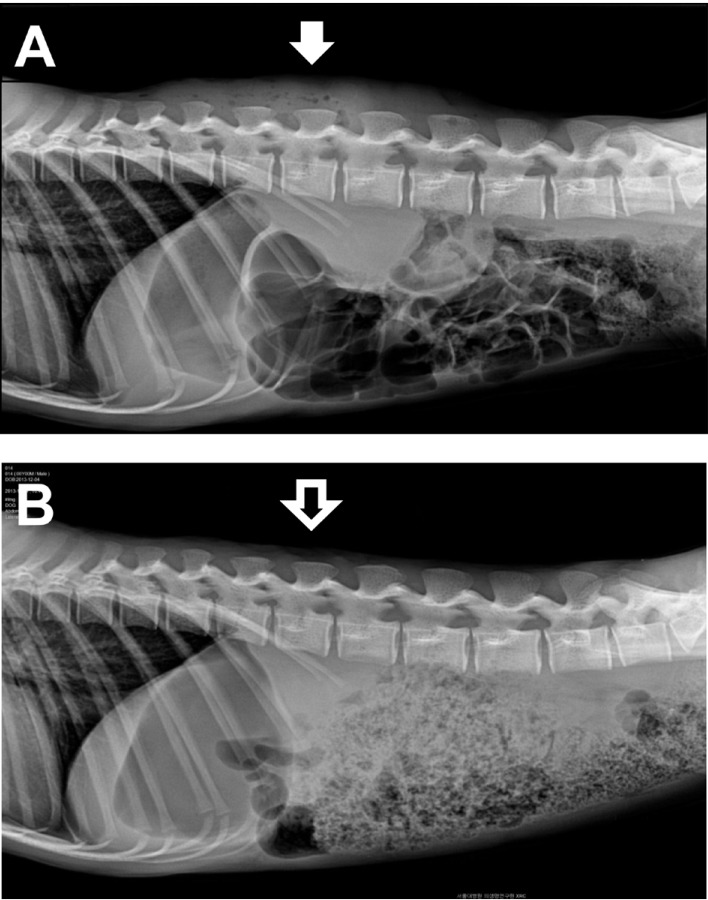Lab Anim Res.
2014 Dec;30(4):181-184. 10.5625/lar.2014.30.4.181.
Suppurative bite wound by repetitive aggression of dominance hierarchy during group housing in rhesus monkeys
- Affiliations
-
- 1Transplantation Research Institute, Medical Research Center, Seoul National University College of Medicine, Seoul, Korea. jaeil@snu.ac.kr
- 2Laboratory of Transplantation Immunology, Department of Medicine, Seoul National University College of Medicine, Seoul, Korea.
- 3Department of Neurology, Seoul National University Hospital, Seoul, Korea.
- KMID: 1737420
- DOI: http://doi.org/10.5625/lar.2014.30.4.181
Abstract
- Group formation of rhesus monkeys, often leads to victims of repeated attacks by the high ranking animal. We reported a case of an injured middle ranking monkey from repetitive and persistent aggression. 4-male rhesus group was formed by a rapid group formation strategy 2 years ago. One monkey in the group suddenly showed depressive and reluctant movement. Physical examination revealed multiple bite wounds and scars in the dorsal skin. Overall increased opacity of the dorsal soft tissue and some free air was observed on radiographic examination. An unidentified anaerobic gram negative bacillus was isolated from the bacterial culture. Reconstructive surgery was performed and in consequence, the wound was clearly reconstructed one week later. Eventually, the afflicted monkey was separated and housed apart from the hierarchical group. This case report indicate that group formation in rhesus monkeys is essentially required sufficient time and stages, as well as more attention and a progressive contact program to reduce animal stress and fatal accidents.
Keyword
MeSH Terms
Figure
Reference
-
1. McKinney WT Jr. Primate social isolation. Psychiatric implications. Arch Gen Psychiatry. 1974; 31(3):422–426. PMID: 4415204.2. Olsson IAS, Westlund K. More than numbers matter: The effect of social factors on behaviour and welfare of laboratory rodents and non-human primates. Appl Anim Behav Sci. 2007; 103:229–254.
Article3. Reinhardt V, Houser D, Eisele S. Pairing previously singly caged rhesus monkeys does not interfere with common research protocols. Lab Anim Sci. 1989; 39(1):73–74. PMID: 2918690.4. Bernstein IS, Gordon TP, Rose RM. Factors influencing the expression of aggression during introductions to rhesus monkeys groups. In : Holloway RL, editor. Primate aggression, territoriality, and xenophobia: a comparative perspective. New York: Academic Press;1974. p. 211–240.5. Fairbanks LA, McGuire M, Kerber W. Effects of group size, composition, introduction technique and cage apparatus on aggression during group formations in rhesus monkeys. Psychol Rep. 1978; 42(1):327–333. PMID: 417359.6. Rose RM, Bernstein IS, Gordon TP. Androgen and aggression: A review and recent findings in primates. In : Holloway RL, editor. Primate aggression, territoriality, and xenophobia: a comparative perspective. New York: Academic Press;1974. p. 275–304.7. Lee JI, Lee CW, Kwon HS, Chung DH, Park CG, Kim SJ, Kang BC. Prevalence and causes of wound of rhesus monkey in the laboratory nonhuman primate facility. Lab Anim Res. 2008; 24:293–296.8. Kaplan JR, Manuck SB, Clarkson TB, Lusso FM, Taub DM. Social status, environment, and atherosclerosis in cynomolgus monkeys. Arteriosclerosis. 1982; 2(5):359–368. PMID: 6889852.
Article
- Full Text Links
- Actions
-
Cited
- CITED
-
- Close
- Share
- Similar articles
-
- Heavy metal concentrations in hair of newly imported China-origin rhesus macaques (Macaca mulatta)
- Intratracheal inoculation of human varicella zoster virus (VZV; MAV strain) vaccine successfully induced VZV IgG antibodies in rhesus monkeys
- Reference values of hematological and biochemical parameters in young-adult cynomolgus monkey (Macaca fascicularis) and rhesus monkey (Macaca mulatta) anesthetized with ketamine hydrochloride
- Experimental Production of Arteriosclerosis in Rhesus Monkeys by Deficiency of Pyridoxine Hydrochloride (Vitamin B-6) and Essential Fatty Acids
- Evaluation of the Differences of Myocardial Fibers between Acute and Chronic Myocardial Infarction: Application of Diffusion Tensor Magnetic Resonance Imaging in a Rhesus Monkey Model



